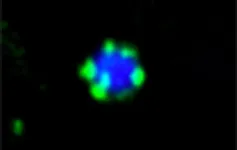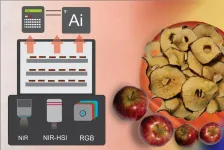(Press-News.org) BIRMINGHAM, Ala. – In a large-animal model study, researchers have found that heart attack recovery is aided by injection of heart muscle cell spheroids derived from human induced pluripotent stem cells, or hiPSCs, that overexpress cyclin D2 and are knocked out for human leukocyte antigen classes I and II. This research, published in the journal Circulation Research, used a pig model of heart attacks. Pig hearts more closely resemble the human heart in size and physiology, and thus have a higher clinical relevance to human disease, compared to studies in mice.
University of Alabama at Birmingham researchers, led by Jianyi “Jay” Zhang, M.D., Ph.D., and Lei Ye, M.D., Ph.D., generated the human leukocyte antigen-knockout and cyclin D2-overexpressing hiPSCs, called KO/OEhiPSCs. When KO/OEhiPSCs were differentiated into cardiomyocyte spheroids and implanted into the pig hearts that had undergone ischemia/reperfusion injury, the KO/OEhiPSC-cardiomyocyte implantation resulted in significantly improved cardiac function and reduced infarct size after four weeks.
“It is widely acknowledged that the infarct size is linearly related to the severity of post-infarction left ventricle remodeling and the occurrence of heart failure,” Zhang said. “In our current study, at week 4 after ischemia/reperfusion, we observed a significant 35.8 percent decrease in the infarct area in the hearts treated with the KO/OEhiPSC-cardiomyocyte spheroids compared with those treated with basal medium, and a significant reduction compared with wildtype-hiPSC-cardiomyocyte spheroid-treated pigs.”
These improvements were due to a surprising finding — proliferation of endogenous heart muscle cells in the pig hearts. This is particularly noteworthy because shortly after birth mammalian heart muscle cells lose their ability to divide. Thus, a damaged heart after a heart attack cannot repair itself by growing new muscle cells in the scar area left by the heart attack. Many previous pig model preclinical trials to inject new heart muscle cells into the damaged heart have been blunted by general failure of the cells to engraft and grow.
In the current study, the spheroids that the UAB researchers injected failed to persist, despite finding significant improvement in heart function and infarct size in the damaged pig hearts. Engraftment was seen at week 1, but was nearly undetectable at week 4. Instead, the researchers found significant increases in the proliferation of endogenous pig cardiomyocytes, those preexisting heart muscle cells that are unable to divide in normal adult hearts. These proliferating cells showed elevated expression levels of cellular proliferation markers, and they expressed genes for DNA replication. The pig cardiomyocyte cells also showed upregulation of three signaling pathways — the Mitogen-Activated Protein Kinase pathway, the HIPPO/YAP pathway and the Transforming Growth Factor Β pathway.
Researchers analyzed the heart cells for cell-surface receptors that are associated with the three pathways, and they looked for differential extracellular protein expression of proteins that interact with those cell-surface markers receptors. They did not see differential expression of the extracellular proteins in the endogenous cardiomyocytes. This suggested that the enhanced proliferation of the endogenous heart muscle cells might instead be due to extracellular proteins produced by the injected KO/OEhiPSC-cardiomyocytes.
Cytokine arrays of the KO/OEhiPSC-cardiomyocytes identified follistatin, an autocrine glycoprotein, as the potential inducer of the heart muscle cell proliferation. Follistatin was found to be highly secreted by KO/OEhiPSC-cardiomyocytes. In cell culture, human cardiomyocytes significantly proliferate, and the total number cardiomyocytes increased by 30 percent when treated with follistatin as compared to the control groups. In an in vivo mouse model of heart attacks, the UAB researchers found that injected follistatin induced proliferation of adult mouse cardiomyocytes after myocardial infarction. Other experiments confirmed that follistatin targets the HIPPO/YAP signaling pathway to promote the growth of cardiomyocytes.
“To our knowledge, this is the first report demonstrating that follistatin promotes the proliferation of hiPSC-cardiomyocytes and cardiomyocytes from adult mammalian hearts,” Zhang said. “The mechanisms by which follistatin activates cardiomyocyte proliferation have yet to be deciphered.”
The need for a new therapy for heart attack patients is great. Heart failure is responsible for 13 percent of deaths worldwide, and half of patients with heart failure die within five years. Blockage of coronary arteries in a heart attack leads to death of the cardiomyocyte heart muscle cells. When that muscle tissue is replaced by dense scar tissue with little blood circulation, the infarcted heart loses contractile power, leading to heart enlargement, progressive loss of pumping ability, increased chance of ventricular arrhythmias and clinical end-stage heart failure.
The current study advances a 2021 study by Zhang and colleagues that showed heart attack recovery could be aided by injection of heart muscle cells that overexpress cyclin D2. However, these experiments were done in immunocompromised mice. The current study developed and tested hypoimmunogenic and cyclin D2-overexpressing hiPSC-cardiomyocytes in a large-animal model for possible clinical translation and enhanced therapeutic efficacy of this promising treatment approach.
“This highlights the significant potential of KO/OEhiPSC-cardiomyocytes to stimulate endogenous cardiomyocyte proliferation in the hearts of adult patients,” Zhang said.
Co-authors with Ye and Zhang in the study, “Follistatin from hiPSC-cardiomyocytes promotes myocyte proliferation in pigs with postinfarction LV remodeling,” are Yuhua Wei, Gregory Walcott, Thanh Nguyen, Xiaoxiao Geng, Bijay Guragain, Hanyu Zhang, Akazha Green, Manuel Rosa-Garrido and Jack M. Rogers, UAB Department of Biomedical Engineering; and Daniel J. Garry, UAB Department of Medicine, Division of Cardiovascular Disease.
Support came from National Institutes of Health grants HL114120, HL131017, HL134764, HL160476 and HL49137.
At UAB, Zhang holds the T. Michael and Gillian Goodrich Endowed Chair of Engineering Leadership. Biomedical Engineering is a joint department in the Marnix E. Heersink School of Medicine and the UAB School of Engineering. Medicine is a department in the Heersink School of Medicine.
END
Cell-based therapy improves outcomes in a pig model of heart attacks
Injecting infarcted pig hearts with specially bioengineered cells significantly decreased the infarct area and improved heart function, showing possible clinical relevance
2025-01-07
ELSE PRESS RELEASES FROM THIS DATE:
Researchers have a better understanding of how our cells dispose of waste while developing ways to control it
2025-01-07
Recycling takes place in our cells at all times: in a process called autophagy, cell components that are no longer needed are enclosed by membranes and broken down into their basic building blocks. This vital process prevents the formation of harmful aggregates and makes nutrients available again. A research team co-led by Prof. Dr. Claudine Kraft from the CIBSS Cluster of Excellence at the University of Freiburg and Dr. Florian Wilfling from the Max Planck Institute of Biophysics in Frankfurt has now discovered the conditions necessary for autophagy to start. They were also able ...
Earth’s air war: Explaining the delayed rise of plants, animals on land
2025-01-07
New Haven, Conn. — If you like the smell of spring roses, the sounds of summer birdsong, and the colors of fall foliage, you have the stabilization of the ozone layer to thank for it. Located in the stratosphere, where it shields the Earth from harmful ultraviolet radiation, the ozone layer plays a key role in preserving the planet’s biodiversity.
And now we may have a better idea of why that took so long — more than 2 billion years — to happen.
According to a new, Yale-led study, ...
More than half of college students report alcohol-related harms from others
2025-01-07
FOR IMMEDIATE RELEASE
Tuesday, January 7, 2025
Contact:
Jillian McKoy, jpmckoy@bu.edu
Michael Saunders, msaunder@bu.edu
##
More than half of US college students experienced alcohol-related harms caused by others, according to the first national probability-based survey of such harms conducted in 20 years. The findings, published in the journal Drug and Alcohol Review in December, shed light on how others’ drinking affects students’ health, academics, and safety.
“Our research ...
Smart food drying techniques with AI enhance product quality and efficiency
2025-01-07
URBANA, Ill.– Food drying is a common process for preserving many types of food, including fruits and meat; however, drying can alter the food’s quality and nutritional value. In recent years, researchers have developed precision techniques that use optical sensors and AI to facilitate more efficient drying. A new study from the University of Illinois Urbana-Champaign discusses three emerging smart drying techniques, providing practical information for the food industry.
“With traditional drying systems, you need to remove samples to monitor the process. But with smart drying, or precision drying, you can continuously ...
Typical cost of developing new pharmaceuticals is skewed by high-cost outliers
2025-01-07
The typical cost of developing new medications may not be as high as generally believed, with a few ultra-costly medications skewing public discussions about the cost of pharmaceutical research and development, according to a new RAND study.
Using a novel method to assess spending on research and development for 38 drugs that were recently approved by the U.S. Food and Drug Administration, researchers found that the mean, or average, cost of developing a new drug was much higher than the mid-point (median) cost of development.
Researchers estimated a median direct research and development cost of $150 million compared to a mean of $369 million.
Costs ...
Predicting the progression of autoimmune disease with AI
2025-01-07
HERSHEY, Pa. — Autoimmune diseases, where the immune system mistakenly attacks the body’s own healthy cells and tissues, often have a preclinical stage before diagnosis that’s characterized by mild symptoms or certain antibodies in the blood. However, in some people, these symptoms may resolve before culminating in the full disease stage.
Knowing who may progress along the disease pathway is critical for early diagnosis and intervention, improved treatment and better disease management, according to a team led by researchers from the ...
Unlocking Romance: UCLA offers dating program for autistic adults
2025-01-07
Love doesn’t come with an instruction manual, but for autistic adults seeking to navigate the complexities of romance, a UCLA Health program offers a roadmap to finding and sustaining meaningful relationships through the launch of a new research study, called PEERS for Dating.
Led by the UCLA Program for the Education and Enrichment of Relationship Skills (PEERS) Clinic, the new 20-week program aims to demystify the often complex social rules surrounding dating and help participants gain a deeper understanding of relationship dynamics
“Romantic relationships can be transformative, but for many autistic adults, the path to connection can feel uncertain,” ...
Research Spotlight: Researchers reveal the influences behind timing of sleep spindle production
2025-01-07
How would you summarize your study for a lay audience?
Our research focuses on sleep spindles—short bursts of brain activity during sleep that are crucial for stabilizing sleep and supporting memory.
Sleep spindles are of great interest because changes in spindle activity have been linked to many neurodevelopmental and neurodegenerative disorders, such as Alzheimer’s disease and autism.
While many factors influence when and how these spindles occur, such as sleep stages or brain rhythms, we discovered that short-term patterns, like a musical rhythm spanning just a few seconds, play the most ...
New research reveals groundwater pathways across continent
2025-01-07
Researchers from Princeton University and the University of Arizona have created a simulation that maps underground water on a continental scale. The result of three years’ work studying groundwater from coast to coast, the findings plot the unseen path that each raindrop or melted snowflake takes before reemerging in freshwater streams, following water from land surface to depths far below and back up again, emerging up to 100 miles away, after spending from 10 to 100,000 years underground.
The simulation, published Jan. 6 in the journal Nature Water, shows that rainfall and snowmelt ...
Students and faculty to join research teams this spring at Department of Energy National Laboratories and a fusion facility
2025-01-07
WASHINGTON, D.C. - A diverse group of 164 undergraduate students and six faculty will participate in unique workforce development programs at 11 of the nation’s national laboratories and a fusion facility during Spring 2025.
This opportunity is part of a continuing effort by the Department of Energy (DOE) to ensure the nation has a strong, sustained workforce trained in the skills needed to address the energy, environment, and national security challenges of today and tomorrow.
“The ...
LAST 30 PRESS RELEASES:
New software sheds light on cancer’s hidden genetic networks
UT Health San Antonio awarded $3 million in CPRIT grants to bolster cancer research and prevention efforts in South Texas
Third symposium spotlights global challenge of new contaminants in China’s fight against pollution
From straw to soil harmony: International team reveals how biochar supercharges carbon-smart farming
Myeloma: How AI is redrawing the map of cancer care
Manhattan E. Charurat, Ph.D., MHS invested as the Homer and Martha Gudelsky Distinguished Professor in Medicine at the University of Maryland School of Medicine
Insilico Medicine’s Pharma.AI Q4 Winter Launch Recap: Revolutionizing drug discovery with cutting-edge AI innovations, accelerating the path to pharmaceutical superintelligence
Nanoplastics have diet-dependent impacts on digestive system health
Brain neuron death occurs throughout life and increases with age, a natural human protein drug may halt neuron death in Alzheimer’s disease
SPIE and CLP announce the recipients of the 2025 Advanced Photonics Young Innovator Award
Lessons from the Caldor Fire’s Christmas Valley ‘Miracle’
Ant societies rose by trading individual protection for collective power
Research reveals how ancient viral DNA shapes early embryonic development
A molecular gatekeeper that controls protein synthesis
New ‘cloaking device’ concept to shield sensitive tech from magnetic fields
Researchers show impact of mountain building and climate change on alpine biodiversity
Study models the transition from Neanderthals to modern humans in Europe
University of Phoenix College of Doctoral Studies releases white paper on AI-driven skilling to reduce burnout and restore worker autonomy
AIs fail at the game of visual “telephone”
The levers for a sustainable food system
Potential changes in US homelessness by ending federal support for housing first programs
Vulnerability of large language models to prompt injection when providing medical advice
Researchers develop new system for high-energy-density, long-life, multi-electron transfer bromine-based flow batteries
Ending federal support for housing first programs could increase U.S. homelessness by 5% in one year, new JAMA study finds
New research uncovers molecular ‘safety switch’ shielding cancers from immune attack
Bacteria resisting viral infection can still sink carbon to ocean floor
Younger biological age may increase depression risk in older women during COVID-19
Bharat Innovates 2026 National Basecamp Showcases India’s Most Promising Deep-Tech Ventures
Here’s what determines whether your income level rises or falls
SCIE indexation achievement: Celebrate with Space: Science & Technology
[Press-News.org] Cell-based therapy improves outcomes in a pig model of heart attacksInjecting infarcted pig hearts with specially bioengineered cells significantly decreased the infarct area and improved heart function, showing possible clinical relevance





